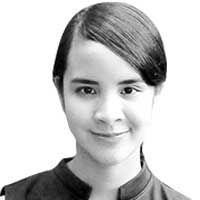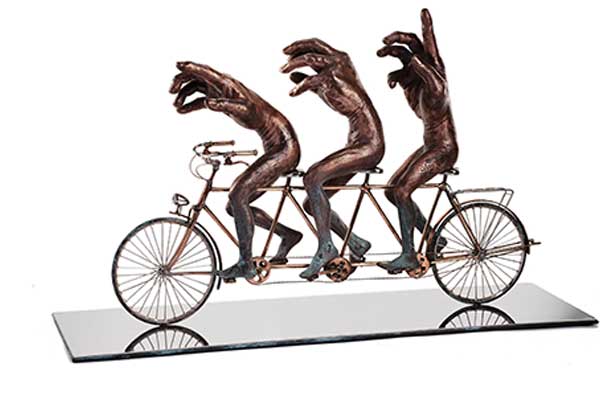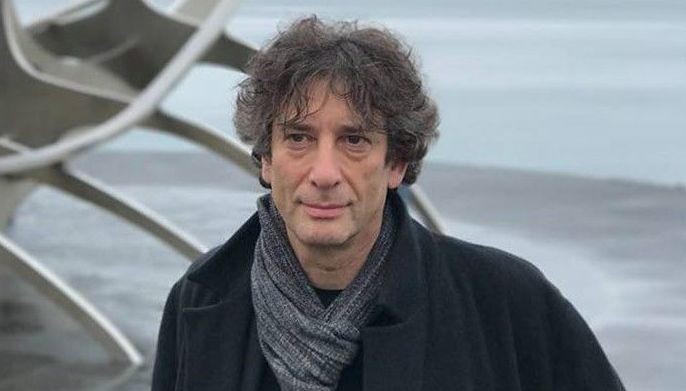Daniel dela Cruz casts a story of artists’ hands


“Many Hands Make Light Work” by Daniel dela Cruz
By Sept. 24, a throng of hands will have populated the Pinto Academy for Arts and Sciences, some emerging eerily out of painted cabinets, some having the anthropomorphic capacity of riding on little bikes, others like objects long dead resting peacefully on their glass box. In this exhibit spearheaded by sculptor Daniel dela Cruz, the hands of 24 prominent local artists have been cast in resin, eternally suspended in time, or moving every now and then when no one’s looking.
“Hands — they’re what the artists use to make a living. I live off my hands,” says dela Cruz. “And from a collector’s point of view, I collect the artist’s work, I’d love to have a copy of their hands; you see all the characters of the people there.”
Juan Alcazaren, Max Balatbat, Renz Baluyot, Plet Bolipata, Elmer Borlongan, Zean Cabangis, Mariano Ching, Alfredo Esquillo, Manny Garibay, Renato Habulan, JC Jacinto, Romeo Lee, Ferdie Montemayor, Raffy Napay, Veronica Pee, Christina Quisumbing Ramilo, Arturo Sanchez, Jose Santos III, Pam Yan-Santos, Soler Santos, Yasmin Sison, Hamilton Sulit, and Reg Yuson complete the cast of “Helping Hands Chapter 1,” running until Oct. 8 at the Pinto Academy, 1 Sierra Madre St., Grand Heights Rd., Antipolo, Rizal.
“My being a sculptor allowed me to help the artists interpret their visions in a lot of different media: wood, steel, metal, lights, what have you,” says Dela Cruz. The collaboration spawned a series of 12 works per artist, sculptures referencing the craft and character of their creator.
Thread wraps Raffy Napay’s resin-cast hands, giving emphasis to the material that prompted his shift from painting. Alfredo Esquillo depicts the wounds of Christ on hands forming the figure of a dove, a sculpture based on one of his paintings, and reflecting his penchant for invoking cultural tropes and icons of the sacred.
Plet Bolipata, whose series is decidedly the most elaborate in the exhibit, spins a narrative on the Little Red Riding Hood. Knitting hands, emerging from cabinets and acrylic cases, allude to the artist’s fascination with coaxing imagined creatures into life through a variety of found objects. “I love to knit and crochet in my spare time,” she adds. “Especially, these past few years, with my nieces studying abroad and requesting me to knit or crochet them scarves or beanies for the cold weather. It was my act of love and generosity to them. So knitting and crocheting hands felt like the perfect symbol to represent the kindness and generosity the Helping Hands project wishes to extend to visual artists.”
Initially intended as a small charity exhibit, Dela Cruz’s project has given rise to a more noble, if not ambitious, initiative to give back to the artist’s community. To be launched along with the exhibit is the Visual Arts Helping Hands Foundation, conceived by Dela Cruz and now comprised of an external board represented by artists and art patrons Dr. Joven Cuanang, Trickie Lopa, Jonathan Que, Mike Tomacruz, Manny Garibay, Reggie Yuson, Atty. Tonico Manahan, Dr. Steve Lim and Dr. Raffy Tuason.
The main purpose of the foundation for the first two years, explains Dela Cruz, is simply to address visual artists’ medical emergencies and medical needs. “As the doctor in the group,” says Cuanang, “I will present an agenda of health promotion and disease prevention for the artists and their families. We will establish a group of medical experts in all fields who will assist them when they get sick.”
As a counterweight to the increasing commercialism in the art scene, the foundation similarly makes a case for art made and sold for the purpose of enriching the art community at large. “To provide for the emergency needs of the artists is the immediate purpose of the foundation. But I think what’s more important is the spirit of community it creates among artists,” says Garibay.
“In the art scene,” Garibay continues, “very few artists have the fortune of living comfortably off their art. Most are actually struggling to get a share of the market. A foundation that encourages sharing and compassion especially from more established artists can start a culture that hopefully will be observed by everyone including the galleries.”
From the collaborative process of making the sculptures to how they’re sold and where the proceeds go, “Helping Hands Chapter 1” aims at demonstrating the possibilities of making art more democratic.
The 300 or so resin-cast hands from the different artists’ series are grouped into collections of six. Whether a set includes Jacinto’s ceramic hands entombed in glass, Dela Cruz’s hands aboard a bicycle, or Borlongan’s handcuffed hands praying to a deity somewhere, collectors will pay the same price for any collection. “It’s different, it’s changing the game,” says Dela Cruz of the effort to render the pieces with equal value and level the playing field.
The token piece in the exhibit, called “Chapter 1,” is a composite of all the artists’ hands, on blocks resembling pieces in a board game. “You can move the hands around,” says Dela Cruz, “The main point again is (to have) no one above another, and there are slots left open — the reason being the story is not done. The title is “Chapter 1.” It’s just the beginning. More and more will come in the future; there is space for everyone to join.”
“Chapter 1” draws attention to details lending distinct character to the artists: the smallness of Sison’s hands, the lines in Borlongan’s, and all the telling gestures. The historic piece goes up for silent auction to benefit the Center for Possibilities. Through the exhibit, the focus shifts from the individual to the community. Hands hearken to the artist’s capacity to breathe life into objects, to create, to preserve, and in this case, to build — to establish not only a foundation but a strong sense of kinship in the art field.
As Dela Cruz puts it, “What we are working on, what we are putting together, is something that is meant to outlive any of us. Long after all of us are gone, ideally this will still be there, and will continue. What’s important is that these artists banded together to give birth to this foundation.”



















